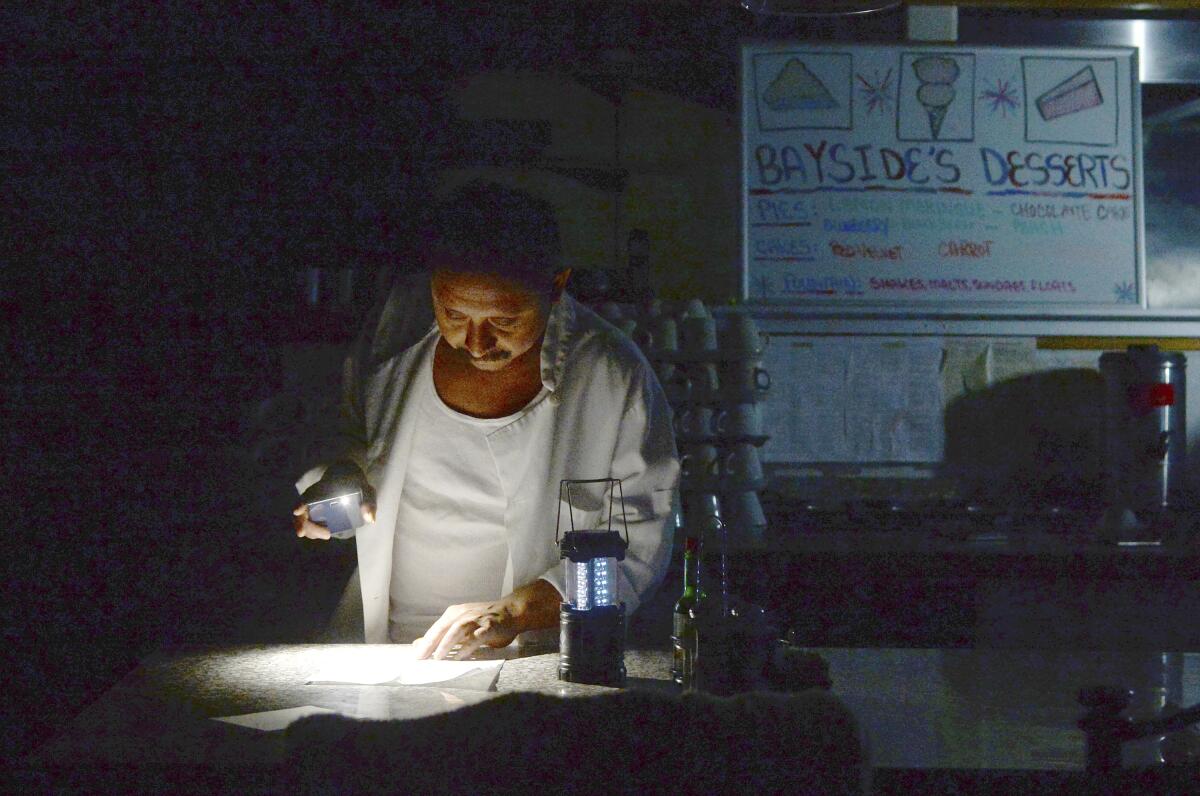Tempers flare as millions in California endure power outages from PG&E

PLACERVILLE, Calif. — Classes were canceled. Frozen foods melted. Hospitals switched to emergency generators. Blooms withered in florists’ coolers. Unused food was jettisoned at shuttered restaurants. Lines formed at gas stations. Cellphones faded out.
That’s what happened Wednesday when the state’s largest utility shut off power to millions of Californians in a drastic attempt to avoid the killer wildfires that have charred hundreds of thousands of acres, caused billions of dollars in damage and spurred cries for widespread change in how electricity is delivered over the state’s aging grid.
Millions of Californians could spend days without power as the state’s largest utility continues shutting off electricity in a desperate attempt to avoid wildfires sparked by windblown power lines.
Pacific Gas & Electric Co. began cutting power to customers shortly after midnight in counties around Sacramento. By the end of the day, the outages had radiated out to encompass 34 counties, with all but seven counties north of Merced at least partly in the dark.
PHOTOS: Northern California deals with unprecedented power outages
About 800,000 customers were expected to lose power Wednesday, leaving more than 2 million people without lights, air conditioning, computers and refrigerators. Gusty conditions are expected through Thursday morning, and PG&E fears windblown electrical lines could spark fires if power is not cut.
The move by PG&E marks the largest power shut-off to date as California utilities attempt to reduce wildfire risks. Equipment malfunctions have been tied to some of the state’s most destructive and deadliest fires, including the 2017 wine country blazes and last year’s Camp fire, which devastated the town of Paradise and killed 85 people.
In January, PG&E filed for Chapter 11 bankruptcy protection, anticipating multibillion-dollar legal claims stemming from the Camp fire, which also destroyed nearly 14,000 homes. A month later, officials at the utility acknowledged that its equipment probably sparked that blaze.
“The safety of our customers and the communities we serve is our most important responsibility, which is why PG&E has decided to turn power off to customers during this widespread, severe wind event,” Michael Lewis, PG&E’s senior vice president of electric operations, said Wednesday. “We understand the effects this event will have on our customers and appreciate the public’s patience as we do what is necessary to keep our communities safe and reduce the risk of wildfire.”
But tempers flared against the utility everyone loves to hate — enough so that a cautious PG&E erected barriers around its San Francisco headquarters Wednesday. At the same time, the California Highway Patrol was investigating whether someone shot at a PG&E truck Tuesday night.
The CHP initially reported that a rock had shattered the passenger-side window of one of the utility’s vehicles, which was traveling south on Interstate 5 in the small Northern California town of Maxwell. But when an officer took a closer look, there was “some evidence that it might have been a bullet that hit the window,” said Officer Cal Robertson of the CHP’s Northern Division.
PG&E officials did not respond to a request for comment.

The big question circulating through darkened homes and stores Wednesday was whether cutting power is even a good way to stop wildfires.
The state’s fire protection agency has not studied whether power cutoffs have had any effect on the number of wildfires in California, said Scott McLean, spokesman for the California Department of Forestry and Fire Protection, which is not part of the decision-making process when a utility considers such a drastic measure.
“We’re like everybody else — we adapt accordingly,” McLean said. “These power outages aren’t hampering our response capabilities. We’re making sure we have the power and logistical support we need to keep functioning.”
UC Berkeley economics professor Severin Borenstein spent much of Wednesday like everyone else in Northern California: preparing for the PG&E blackout to arrive. Classes were canceled at UC Berkeley, which was notified by PG&E that power would be cut to most of the core campus by 11 a.m.
Without a backup generator or a stockpile of spare phone chargers, Borenstein’s plan to keep his refrigerator cool and his phone running was to connect each device to a charger that would get juice from his car, which he’d leave idling as long as necessary.
“I’ve packed the freezer with ice to keep it cool, but if I can run [the refrigerator] off our car for a couple of hours a day to bring it to minimum temperature, that will help,” Borenstein said. “It’s a pain in the ass. This is why we live in a modern economy, so we don’t have to spend most of our lives doing these things.”
But how Borenstein and millions of other Californians — and the utilities that serve them — arrived at this point began long before this week’s weather forecast or the fires that have ravaged the state over the last few years.
PG&E’s shutdown strategy to avoid starting fires is the result of California’s energy economy being thrown off balance by climate change, Borenstein said. Southern California Edison has announced that it also could cut power to customers, but on a smaller scale. San Diego Gas & Electric Co. has taken similar measures in the past.
“Utilities have been having transmission and distribution failures since there’s been electricity, and they’ve started fires,” Borenstein said. “The difference is in the last decade we’ve seen the start of massive fires in ways that weren’t happening before.”
Because of the blackout, classes were canceled at campuses throughout Northern California. All facilities in the El Dorado Union High School District in the Sierra foothills east of Sacramento were closed Wednesday; the district said it would extend the cancellations into a second day Thursday. The California State University system canceled classes at Sonoma State and Humboldt State, affecting about 17,000 students.
In the Sierra foothills town of Placerville, the power went out about 3 a.m., leaving many residents angry and scrambling for supplies. Customers roamed the aisles of Placerville Hardware in darkness at midmorning, loading up on flashlights, oil lamps and batteries. Cash registers ran on a generator.
“There isn’t a tree moving right now because of the wind,” said Tod Pickett, who was buying battery-powered lamps. “And they are telling us there’s a hurricane. There are 12 billion reasons why PG&E is sticking it to us,” he continued, referring to the monetary settlements paid after past fires.
Pickett wasn’t the only Californian on Wednesday to accuse PG&E of putting its interests ahead of its customers’. Lilli Heart eventually took the utility to task, too. But it took her a while to reach that point.
The power in her lakefront home in Cottonwood went out at 12:30 a.m. Wednesday. At first, her Facebook posts were upbeat, even cheerful. She’d lost everything in the Camp fire 11 months earlier, so what’s a little darkness to a 73-year-old survivor who fled Paradise and started over?
“OK power now down glad I just got my bowl of ice cream eating by flashlight,” she wrote, signing off with a heart emoji.
Eleven or so hours later, she was still mostly holding her own: “The wind is certainly strong today,” she posted to Facebook. “My hummingbirds are struggling to get to their feeders. They are freaking out. Cold here too. So with no electricity or propane I used what was left to get some hot water out of the tap the last of it to make more nectar for them.”
And another heart.
By lunchtime, though, all bets were off. She’d swung by the vet to pick up medication for her ailing rescue cat and his cancerous thyroid. She then headed to the market for groceries, knowing the place was cash only and all she had on hand was $15.
When Heart answered her cellphone, she let loose on PG&E and its hobbled electrical grid.
“I’m really mad at them,” fumed the jewelry maker who works from a home studio. “We’ve had high winds in California for years and they’ve never shut down the power. It’s unconscionable…. They’re talking about possibly six days. I have nine orders today. I can’t fill my orders. And that’s just me. Some people are on oxygen. I think the governor needs to step in and do something.”
Here’s what experts say are the best ways to communicate during and after an emergency.
The governor did do something Wednesday, but not what Heart had in mind. At a housing-related event in San Diego, Gov. Gavin Newsom said he supports the utility’s decision to take “proactive measures” in the face of severe wildfire conditions.
But he lashed out, again, at PG&E leadership for not putting more effort over the years into preparing the company’s infrastructure for inevitable fire danger.
“They’re in bankruptcy because of their terrible management, going back decades,” Newsom said. “It’s time for them to do the right thing — get out of bankruptcy and get this system into the 21st century.”
Not everyone was venting Wednesday.
Lake County lost power in the early morning, in such widespread fashion that Sheriff Brian Martin said he thought it was “virtually our entire county that is shut off.”
Unlike in earlier power outages, PG&E is working closely with the county to locate residents with sensitive medical needs who may rely on power to survive. Hospitals, county courthouses, local government offices and traffic signals are operating off generators.
“It’s having a significant impact on us as a community up here,” Martin said. “I think we’re as prepared as we can be.”
Luna and McGreevy reported from Northern California; La Ganga and Serna from Los Angeles. Times staff writers John Myers, Anita Chabria, Melody Gutierrez, Maura Dolan and Phil Willon in Northern California and Hannah Fry, Jaclyn Cosgrove, James Peltz, Richard Winton, Colleen Shalby, Liam Dillon and Alejandra Reyes-Velarde in Los Angeles contributed to this report.
More to Read
Sign up for Essential California
The most important California stories and recommendations in your inbox every morning.
You may occasionally receive promotional content from the Los Angeles Times.
















